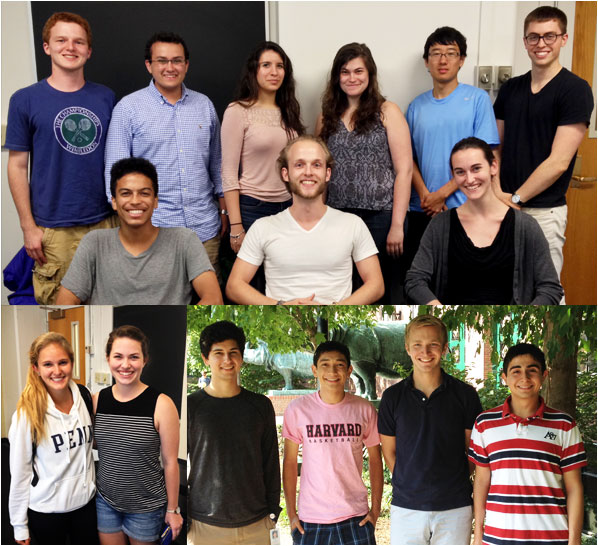SUMMER 2014 ANIMATIONS

Above: 2014 HHMI Interdisciplinary Undergraduate Fellows
Inhibiting Microbial Enzymes that Impact Human Health
The Little Enzymes that Could (Though We Really Wish They Didn’t)
Content Creator Credits: Jonathan Marks ’15 and Wendy Woodin ‘17
Jonathan’s faculty advisor: Emily Balskus
Wendy’s faculty advisor: Daniel Kahne
Microbes are an essential part of our daily life. However, sometimes microbes make molecules that can hurt us. How can we stop these microbes from creating harmful products? This animation provides an overview of both computational and biochemical approaches to the discovery of enzyme inhibitors to halt the production of toxic molecules.
Biological Systems and Adaptability
Microbial Communities in Cheese and the Human Microbiome
Content Creator Credits: Donald J. Brooks ’17 and Daniel H. F. Rubin ‘17
D.J.’s faculty advisor: Nicolas Chevrier
Dan’s faculty advisor: Rachel Dutton
How do biological systems respond and adapt to changing stimuli presented by the environment? This question is important for microscopic communities, like those made up of microbes, and in broader contexts, like the human body. On a small scale, Dan studies the effects of an invading organism on the bacteria and fungi that make up a cheese rind. D.J., from a larger perspective, uses a novel method called CLARITY to make tissues transparent and see where pathogens are traveling in human organs. By studying these interactions, we can begin to understand the complex behavior of biological systems.
Genome Wide Association Studies and Human Disease, Learning from Toxic Frogs
Content Creator Credits: Stephanie Caty ’15 and Andy Shi ‘15
Stephanie’s faculty advisor: Lauren O’Connell
Andy’s faculty advisor: Curtis Huttenhower
Genome wide association studies compare genomes of various organisms to identify genomic differences that are correlated with differences in complex phenotype expression. In the O’Connell lab, such techniques are used to identify proteins involved in making poison dart frogs toxic. In our animation, we present an overview of genome wide association studies as applied to understanding poison dart frog toxicity and their application for also understanding complex human diseases.
Stem Cell Pluripotency and Differentiation
Manipulating the Genetic Rubik’s Cube
Content Creator Credits: Kameron Kooshesh ’16 and Jamasb Sayadi ‘17
Kameron’s faculty advisor: Richard Maas
Jamasb’s faculty advisor: Ole Isacson
In order to unlock the exciting potential of stem cells for therapeutics, researchers are looking for predictive means to manipulate their development. Differentiating stem cells consistently through a replicable procedure can be thought of as “programming” the process of development. This animation explores how scientists can use small molecule signaling and genome editing to implement developmental programs and achieve defined cell states, visualized here as solving for different patterns on a Rubik’s cube. Programming development like rearranging a Rubik’s cube has applications for reliably creating cell types useful in medicine, such as the parathyroid cell for hypoparathyroidism, and in genetics research, such as dissecting the function of enhancers in development.
Visualizing Cell Communication
Content Creator Credits: Danny J. Kramer ‘15
Danny’s faculty advisor: Thomas Michel
Studying the position and movements of molecules inside of cells can offer valuable insight into the critical roles these molecules play in cellular functions. How can we study the behavior of something as small as a molecule? This animation explains how scientists use fluorescence microscopy and FRET (fluorescence resonance energy transfer) to amplify and directly visualize molecular communications inside of living cells. This technique allows us to decipher cell signaling cascades that detect, amplify, and integrate diverse external signals to generate essential cellular responses. In my research this technique provides us a powerful tool to identify and understand complex signaling pathways that are used to regulate all areas of cardiovascular function, from blood pressure to cholesterol and heart disease.
Methods of Decision Making
Content Creator Credits: Jeffrey G. Edwards ’15 and Malte Zopfs ‘15
Malte and Jeffrey's faculty advisor: Joshua Buckholtz
From deciding which clothes to wear to deciding what career to pursue, decision-making plays a large role in every person's life. As such, there is a strong interest in studying the underlying biological mechanisms for decision-making, as a possible way to optimize the outcomes of these decisions. Our animation explains multiple biological approaches to studying decision-making in humans: through brain-imaging (fMRI and PET) and non-invasive brain stimulation (tDCS). With these technological innovations, we are able to gain great insight into the fascinating biology behind the decisions we make.